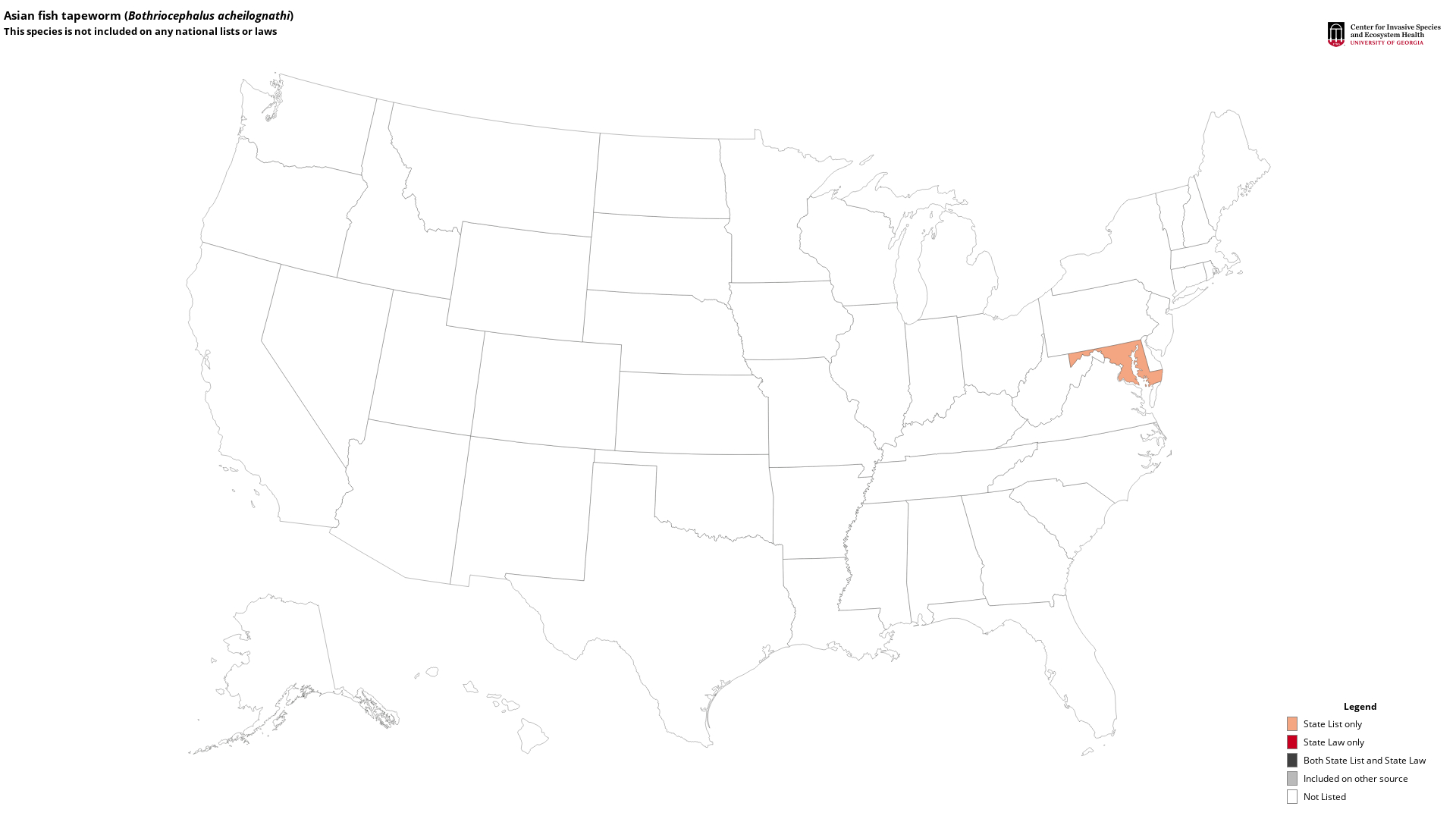Asian fish tapeworm
(Bothriocephalus acheilognathi)
This species is Introduced in the United States
Overview:
The Asian tapeworm is an intestinal parasite of primarily cyprinid (carp) fish species, but has been reported in an estimated 200 species of freshwater fish. It is native to East Asia and is now present in all continents, except Antarctica, due to human activities.1
B. acheilognathi is primarily spread by infected fish but it can also colonize copepods (small crustaceans) so movement of water containing tapeworm eggs or infected copepods can also disperse this parasite.1 It has a relatively simple lifecycle, requiring only one intermediate host which are copepods.2
Introductions of common carp and grass carp are the most likely vectors for this parasite arriving in North America, however discovery of the Asian tapeworm often lagged the introduction of the host, in some cases by decades.1 In 2003 a single, immature B. acheilognathi specimen was collected from a white bass in the southern basin of Lake Winnipeg.3 The white bass is unlikely the source of the tapeworm since common carp have long been established in Lake Winnipeg.3 This discovery extended the Asian tapeworm's known northern range by over 900 kms.3 Fish-eating birds which consume infected fish can transport eggs and spread them via defecation.1
Since the tapeworms first description it has been identified under 20 different specific epithets and this splitting was often the result of variability in morphology and sample fixation procedures (the scolex and bothria are affected by how they are mounted on slides). Recent studies have declared that all Bothriocephalus in cyrpinids are the same species.1
Three species can be confused with B. acheilognathi - Eubothrium tulipai, E. rectangulum, and Bathybothrium rectangulum have similar scolex but have lateral rather than medial genital openings.1
As of January 1, 2016, the possession, sale, or transport of this species in Alberta is unlawful under the Fisheries Act.
Identification:
Mature B. acheilognathi have a segmented body with an arrowhead or heart-shaped scolex (head) which terminates in a weak apical disc. Bothria (slit-like openings) are located along the axis of the dorsal and ventral surfaces of the scolex.1 It has no neck and the proglottids (body segments) begin directly behind the scolex. The proglottids are much narrower than the scolex.2 The tapeworm's total length varies with host, the ecological setting, age of infection, and the number of worms but 3.5 to 8 cm is typical. Specimens up to 1 m in length have been reported.1
Ecology:
Adult B. acheilognathi are hermaphroditic, each having a complete set of male and female reproductive organs. Eggs are produced via self-fertilization and shed into the water with the host's feces.2 Hatching occurs in water temperatures of 12 to 37 °C and six-hooked larvae emerge. Hatching at 28-30°C takes 1-5 days and 10-28 days at 14-15 °C.2
The free-swimming larvae, coracidia, are consumed by copepods where they develop into a second larval stage called a procercoid. This is also temperature dependent - 11 to 18 days at 29-31 °C and 49 days at 20 °C.2 Fish are normally infected by consuming the copepods, although predatory fish can also consume infected fish. Once in the fish's intestines the larvae mature into adult worms in 21-23 days at 28-29 °C.2
Economic Impacts:
Fish culture operations will face economic losses from fish mortalities, reduced fitness, disinfection of facilities and the costs of treating fish.1 Any declines in native sportfish populations due to tapeworm infection could have impacts on recreation and tourism.
Environmental Impacts:
Infection by B. acheilognathi reduces a fish's ability to cope with reduced food availability and may lead to decreased fitness, growth, and temperature-dependent mortality, especially in juveniles. Infection also causes intestinal inflammation, protein depletion and alters digestive enzyme activity.2
Sociological Impacts:
Asian tapeworm infected fish are safe for human consumption provided thorough cooking, smoking or pickling.2 The transformation of native aquatic communities results in the intrinsic loss of natural capital and enjoyment of natural areas.
Prevention:
B. acheilognathi can be spread by infected fish or contaminated water containing eggs or infected copepods. It can also be spread by infected baitfish.1 Dispose of fish guts, unused bait and other refuse parts in landfill-bound garbage. Koi and goldfish are both cyprinids are could be vectors for Asian tapeworm.1 Never release fish or dump aquariums into natural waters.
Thoroughly drain boat motors, bilge, transom, live wells, and bait buckets of any water that may harbour eggs or infected copepods.
Control:
Prevention of spread is the only control method currently known for Asian tapeworm.1
References:
1Datasheet report for Bothriocephalus acheilognathi. Invasive Species Compendium. www.cabi.org/isc/datasheetreport?dsid=91669 Accessed: March 30, 2017.
2Schyzocotyle acheilognathi USGS Nonindigenous Aquatic Species Database, Gainesville, FL, and NOAA Great Lakes Aquatic Nonindigenous Species Information System, Ann Arbor, MI. nas.er.usgs.gov/queries/greatlakes/FactSheet.aspx?SpeciesID=2798 Revision Date: 7/25/2016. Accessed: March 30, 2017.
3Choudhury, A., et. al. Update on the Distribution of the Invasive Asian Fish Tapeworm, Bothriocephalus acheilognathi, in the U.S. and Canada. Comparative Parasitology 73(2):269-273. 2006. doi: dx.doi.org/10.1654/4240.1 Accessed: March 30, 2017.
Maps
State Lists - This map identifies those states that have this species on their invasive species list or law.
Taxonomic Rank
| Domain: Eukarya |
| Kingdom: Animalia |
| Phylum: Platyhelminthes |
| Class: Cestoda |
| Subclass: Eucestoda |
| Order: Pseudophyllidea |
| Family: Bothriocephalidae |
| Genus: Bothriocephalus |
| Bothriocephalus acheilognathi |
References
Common Name Reference: Web Search - http://www.ncbi.nlm.nih.gov/pubmed/21413512
Scientific Name Reference: Web Search - http://www.ncbi.nlm.nih.gov/pubmed/21413512

